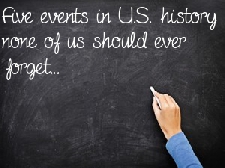History balances the frustration of “how far we have to go” with the satisfaction of “how far we have come.” It teaches us tolerance for the human shortcomings and imperfections which are not uniquely of our generation, but of all time.
~Lewis F. Powell, Jr.
1775 – Picking up where we left the story yesterday …
When 700 British troops arrived at Lexington at about 5:00 a.m., John Adams, John Hancock, and Paul Revere had already fled to Philadelphia. The British troops marched into Lexington to find 77 armed minutemen under Captain John Parker waiting for them on the town’s common green. British Major John Pitcairn ordered the outnumbered Patriots to disperse, and after a moment’s hesitation the Americans began to drift off the green. Suddenly, the “shot heard around the world” was fired from an undetermined gun, and a cloud of musket smoke soon covered the green. When the brief Battle of Lexington ended, eight Americans lay dead or dying and 10 others were wounded. Only one British soldier was injured, but the American Revolution had begun.
When the British troops reached Concord at about 7 a.m., they found themselves encircled by hundreds of armed Patriots. They managed to destroy the military supplies the Americans had collected but were soon advanced against by a gang of minutemen, who inflicted numerous casualties. Lieutenant Colonel Frances Smith, the overall commander of the British force, ordered his men to return to Boston without directly engaging the Americans. The British lines were constantly attacked by Patriot marksmen firing at them Indian-style from behind trees, rocks, and stone walls.
By the time the British finally reached the safety of Boston, nearly 300 British soldiers had been killed, wounded, or were missing in action. The Patriots suffered fewer than 100 casualties.
The battles of Lexington and Concord were the first battles of the American Revolution, a conflict that would escalate from a colonial uprising into a war that, seven years later, would give birth to the independent United States of America.
1861 – The first blood of the Civil War was shed when a secessionist mob in Baltimore attacked Massachusetts troops bound for Washington, D.C. Four soldiers and 12 rioters were killed.
1897 – Fifteen runners started the first Boston Marathon (24.5 miles) but only 10 made it to the finish line. John J. McDermott of New York won the inaugural event with a time of 2:55:10.
1993 – At Mount Carmel in Waco, Texas, the Federal Bureau of Investigation launched a tear-gas assault on the Branch Davidian compound, ending a tense 51-day standoff between the federal government and an armed religious cult. By the end of the day, the compound was burned to the ground, and some 80 Branch Davidians, including 22 children, had perished in the inferno.
1995 – A massive truck bomb exploded outside the Alfred P. Murrah Federal Building in Oklahoma City, Oklahoma. The blast collapsed the north face of the nine-story building, instantly killing more than 100 people and trapping dozens more in the rubble. Emergency crews raced to Oklahoma City from across the country, and when the rescue effort finally ended two weeks later the death toll stood at 168 people killed, including 19 young children who were in the building’s day-care center at the time of the blast.
A massive manhunt for suspects in the worst terrorist attack ever committed on U.S. soil by an American resulted in the capture of Timothy McVeigh, a 27-year-old former U.S. Army soldier who matched an eyewitness description of a man seen at the scene of the crime. On the same day, Terry Nichols, an associate of McVeigh’s, surrendered in Herington, Kansas.
Nichols was later found guilty on one count of conspiracy and eight counts of involuntary manslaughter, and was sentenced to life in prison. McVeigh, died from a lethal injection at the U.S. penitentiary in Terre Haute, Indiana.
